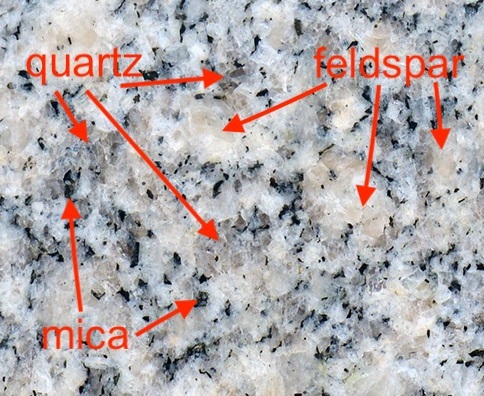This earthcache will help you learn about feldspar and how to identify it.
Have a look at the section underneath the cross with several names on it.
1) Have a look at the panel and describe what you can see - describe the colour and shape of any crystals you can see
2) Examine the crystals in the panel and say whether this rock cooled rapidly or slowly. Give reasons for your answer.
3) What may be present in the feldspar to give it that colour?
4) Take a photo of yourself at GZ, or an identifying item, being careful not to reveal any of the answers to the questions.
Please submit your answers via message though the Geocaching website - there is no need to wait for a response before logging your find.
Granite forms deep within the Earth's crust when molten rock, called magma, slowly cools and solidifies over millions of years. It is composed mainly of three minerals: quartz, feldspar, and mica. During the cooling process, minerals crystallize and form interlocking grains, giving granite its characteristic coarse-grained texture. The size of feldspar crystals in granite is directly related to the speed of cooling. When magma cools slowly beneath the Earth's surface, feldspar crystals have more time to grow larger (greater than 2mm in size), resulting in coarse-grained granite. In contrast, rapid cooling at the surface leads to smaller feldspar crystals, producing fine-grained or even glassy rocks like obsidian.
In environments where tectonic plates collide or where molten rock rises from the mantle, magma can intrude into existing rock formations, gradually cooling and solidifying to form granite plutons. As these plutons cool, the minerals within the magma crystallize, with feldspar crystals growing alongside quartz and mica. The slow cooling process deep underground allows for the development of large feldspar crystals, distinguishing granite from other rocks with finer-grained textures. Over time, uplift and erosion expose these granite plutons at the Earth's surface, where they form prominent features like mountain ranges and rocky outcrops.
The pink colour of feldspar in granite is primarily caused by the presence of a mineral called orthoclase feldspar. Orthoclase feldspar contains small amounts of impurities, such as iron or manganese, which can give it a pink hue. The gray colour of plagioclase feldspar is mainly a result of its mineral composition, which includes a mix of sodium, calcium, and aluminum ions within its structure.
This diagram may help you identify the different features of the granite.

***** PLEASE NOTE IMPORTANT *****
CACHES ARE NOT ALLOWED TO BE PLACED ON ACTUAL MEMORIALS OR WITHIN THE BOUNDARY OF SUCH
AT ALL TIMES PLEASE TREAT LOCATIONS OF MEMORIALS WITH RESPECT